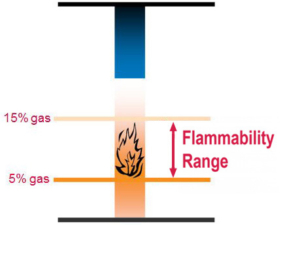Flammability and Ignition Hazards

Natural gas is extremely flammable. This makes it an excellent fuel. It also means that first responders must exercise extreme caution to prevent ignition hazards in the area near any natural gas leak.
Natural gas will only ignite when the volume of gas in air is between 5% and 15%. At concentrations below or above this range, natural gas will not burn. When the volume of gas in air is at least 5%, a gas meter that reads a percentage of lower explosive limit [LEL] will read 100%.
A small spark from any of the following sources can ignite leaking natural gas:
- Cigarettes, e-cigarettes, and vape pens
- Telephones, cell phones, and pagers
- Doorbells and wall switches
- Thermostats and appliance controls
- Flashlights
- Any type of electronic ignition
- Solar and battery backup
- Static electricity
- Running engines (gasoline, diesel, or electric)
- Motors, refrigerators, appliances, and pilot lights
If gas has ignited, let it burn. Burning natural gas will not cause an explosion. Extinguishing a natural gas fire may cause the building or room space to fill with unburned gas, creating an explosion hazard.
